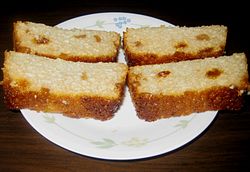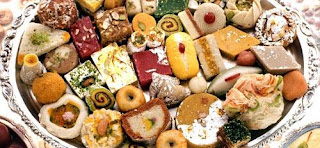 Ancient Sanskrit literature from India mention feasts and offerings of mithas. One of the more complete surviving texts, with extensive description of sweets and how to prepare them is the Manasollasa, means delight of an idea. This ancient info of food, music and other Indian art also known as the Abhilasitartha Cintamani. Manasollasa was composed about 1130 AD, by the Hindu King Someswara III. The document describes meals that include a rice pudding which are called payasam are in modern Indian languages is called Kheer. The socument mentions seven Kinds of rice.
Ancient Sanskrit literature from India mention feasts and offerings of mithas. One of the more complete surviving texts, with extensive description of sweets and how to prepare them is the Manasollasa, means delight of an idea. This ancient info of food, music and other Indian art also known as the Abhilasitartha Cintamani. Manasollasa was composed about 1130 AD, by the Hindu King Someswara III. The document describes meals that include a rice pudding which are called payasam are in modern Indian languages is called Kheer. The socument mentions seven Kinds of rice.Manasollasa also describes rcipies for golamu as a donut from wheat flour and scented with cardamom, gharikas as a fried cake from black gram flour and sugar syrup, chhana as a fresh cheese and rice flour fritter soaked in sugar syrup that the document suggests should be prepared from strained cuedled milk mixed with buttermilk, and many others. Manasollasa mentions numerous milk derived sweets, along with describing the 11th century art of producing milk solids, condensed milk and methods for souring milk to produce sweets. The origin of sweetd in Indian subcontinent has beeb traced to atleast 50 Bc, where records suggest both raw sugar as well as refined sugar were being produced. By 300 Bc, kingdome officials in India were including five kinds of sugar in official documents. By the Gupta dynasty era(3000-5000 AD), sugar was being made not only from sugar cane, but other plant sources such as bhogafor the deities, which after the prayers became Prasad for cevotees, the poor or visitors to the temple.
Sugarcane has been grown in India for thousands of years, and the art of refining sugar was invented there. The English word sugar comes from a Sanskrit word sakhar, while the world candy comes from Sanskrit word khand(jaggery)- one of the simplest raw forms of sweet. Over its long history, cuisines of the Indian Subcontinent developed a diversified array of sweets. Some claim there is no other region of the world where sweets are so varied, so numerous, or so invested with meaning as the Indian Subcontinent. In India's diverse languages, sweets are called by numerous names, one common name being Mithai. They include sugar, and a vast array of ingredients such as different flours, milk, milk solids, fermented foods, root vegetables, raw and roasted seeds, seasonal fruits, fruit pastes and dry fruits. Some sweets such as Kheer are cooked , some like burfi are baked, varities like Mysore pak are roasted, some like jalebiare fried, others like kulfi are frozen, while still others involve a creative combination of preperation techniques. The compostion and recipies of the sweets and other ongredients vary by region. Mithaiare sometimes served with meal, and often included as a form of greeting , celebration, relegious offering, gift giving, parties and hospitality in India. On Indian festivals such as Holi, Dwali, Eid or Raksha Bhandan sweets are hoemade or purchased, then shared. Many social gatherings, wedding ceremonies and religious festivals often include a social celebration of food, and the flavours of sweets are essential elements of such a celebration.
Barfi:

Barfi is a sweet, made from milk solids(khoya) or condensed milk and other ingredients like ground cashews or pistachios. Some barfi use various flours such as besan. Barfi may be flavoured with pastes or pieces of fruits such as mango, banana, berries, coconut. They may include aromatic apices such as cardamom and rose water to enhance the sensual impact while they are consumed.
Sometimes a thin inert silver or gold layer of edble foil is placed on the top of burfi for an attractive presentation. Gold and Silver ar approved food foils in the European Union, as E175 and E174 additives respectively. The independent European food safety certification agency, TUV Rheinland, has deemed gold leaf safe for consumption. Gold ans Silver leaf are certified kosher.
Cham-Cham:
Chhena Murki Cham Chams are prepared from flattened panner sweerened in syrup.
Chhena Murki, or chenna murki, is a sweet made from an Indian version of cottage cheese, milk and sugar are boiled to a thick consistency. Round, cubes, cuboids or other shapes of cottage sheese are soaked in the milky condensate. Other flavours are aromatic spices are typically added. It is also known by Bangladeshi and Guyanese people as pera.

Chhena Poda is a cheese dessert from the state of Odisha in eastren India 'Chhena Poda' literally means 'burnt cheese' in Odia. It is made of well kneaded homemade cottage cheese or chhena, sugar, cashew nuts and raisins, and is baked for several hours until it turns into browns.
Chikki:
Chikki is a ready to eat solid, brittle sweet generally made from casting a mix of dry and hot jaggery syrup. Peanuts and jaggery mix are most common. Other than almonds, cashews, walnuts, sesame and other seeds, varieties of chikki are also prepared from puffed or roasted Bengal gram, puffed rice, beaten rice, puffed seasonal grains, and regional produce such as khobra. Like many Indian sweets, Chikki is typically a high protine delicacy.
Gajrela:
Gajrela, also called Gajar halwa, is a seasonal pudding like sweet made from carrot. It is popular in punjab regions of India and Pakastan, agricultural belt of North India, now common in many parts of south Asia. It is made by slowly cooking carrot with ghee, concentrated and caramelized milk, mawa and sugar, often served with a garnish of aromatic spices, a;monds, cashews or pistachios. The recipes vary by region, and Gajrela may be cooked in Indian Restaurants and is seasonal street and cafe food during post monsoon through spring festive celebrations.
Gulab Jamun:
Gulab Jamun is a common sweet found in Bangladesh, India, Nepal and Pakistan. It is made out of fried chenna balls soaked in sweet rose water flavoured syrup.Jalebi or Imarti:
Jalebi is made by deep frying a fermented batter of wheat flour with yoghurt, in a circukar shape and then soaking it in sugar syrup. Imarti is a variant of Jalebi, with a different flour mixture and has tighter coils. Typically Jalebi is brown or yellow, while Imarti is reddish in colour. Often taken with milk, tea, yogurt or Lassi. In classical Sanskrit literature, jaledis have been reffered to ask kundalika or jalavallika.Kheer or Payas:
Kheer is a pudding, usually made from milk, sugar and one of these ingredients vermicelli, rice, Bulgar wheat, semolina, tapioca, dried dates and sherdded white gourd. It is also known as 'Payas'. As sweet rice pudding, payas has been a cultural dish throught the history of India, being usually found at ceremonies, feasts and celebrations. In many parts of India, ancient traditions maintain that a wedding is not
In many parts of India, ancient traditions maintain that a wedding is not In many parts of India, ancient traditions maintain that a wedding is not fully blessed if payas is not served at the feast during traditional ceremonies like marriage, child birth, anaprasan and other occasions. Other than sweet yoghurt, some families include Kheer in the meal as hospitality and auspicious food before a family member or guest departs on a long journey away from home.
Laddu:
Laddu is made of varieties of flour, grains, pulses, semolina, regional or seasonal fruits, dry fruits and other ingridients cooked with sugar, then shaped into bite size or larger spheres. Laddu is mentioned in ancient Sanskrit documents as temple offerings, and is reffered to as Ladduka. They are popular all ovar India, easy to prepare and come in dozens of varieties. One of the famous Laddu is Tirupathi Laddu so popular that over a million laddus are distributed every week from a single temple of Lore Venkateswara.
Malpoa:

Malpoa is the most ancient homemade sweets of India. It is form of pancake deep fried and sugar syrup.
Narikol Laru:
Narikol Laru is a dessert from Assam. They are ball shaped and made from khoa/condensed milk and coconut, a traditional food during bihu and pujas.
Parwal Ki Mithai:
Parwal Ki Mithai is a dry sweet made of the vegetable parwal, a kind of gourd. The shell of parwal is filled with milk solids, then cooked. It is rather popular in Bihar, but also found in Uttar Pradesh and West Bengal.
 Rasgulla:
Rasgulla:
Rasgulla is a popular sweet in South Asia. They come in many forms, such asKamalabhog (Orange Rasgulla), Rajbhog (Giant Rasgulla), Kadamba often served with kheer, Rasamundi, Raskadamba, and others. Some are white, others cream, brown, gold or orange colored. They are called Rasbari in Nepal. This dish is made by boiling small dumplings of chhenna and semolina mixture in sugar syrup. Once cooked, these are stored in the syrup making them spongy. Increasing the semolina content reduces the sponginess and hardens them, creating variety of textures. Some Rasgulla are stuffed inside with treats, such as dry fruits, raisins, candied peel and other delicacies to create a series of flavors experienced as they are consumed. Some versions, called danedhar, are removed from syrup and sugar coated into shapes of fruits and other creative designs.These are festive foods found year round, in many parts of India.
Rasmalai:
Rasmalai or rosh malai is a dessert eaten in India and Bangladesh. The name ras malai comes from two words in Hindi: ras- means Juics & malai- means cream. It has been described as a"a rich cheese cake' without a crust. Ras malai consists os sugar white, cream or yellow coloured balls of panner soaked in malai flavoured with cardamom.Sandesh:
Sandesh is a sweet made from fine cheese made from cow's milk kneaded with fine ground sugar or molasses. This is a sweet from West Bengal and Odisha. Revered for it's delicate making and appreciated by the connoiseur, this represents sweet making at its finest.Sel roti:
Sel roti is a Nepali home made circular shaped bread or rice donut, prepared during Tihar, a widely celebrated Hindu festival in Nepal. It is made of rice flour with adding customized flavours. A semi liquid rice flour dough is usually prepared by adding milk, water, sugar, butter, cardamom, cloves and other flavours of personal choice.









No comments:
Post a Comment